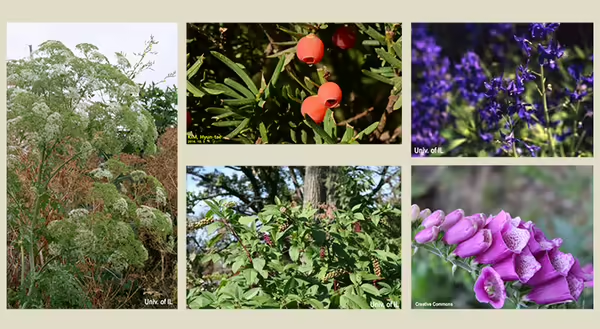
Know which plants are dangerous and protect your family, pets, and animals.
There are many poisonous plants in Illinois, some are native plants and others were introduced into the state.
Poisonous woody plants and flowers found in home landscapes
- Azaleas and their relative, rhododendron, cherished for their beautiful spring flowers, contain the toxin grayanotoxin in their flowers and leaves.
- The American holly, loved for its shiny green leaves and red berries, can cause gastrointestinal distress if eaten.
- The yew family of evergreen shrubs and trees used often in landscape plantings contain the toxin taxine and are considered toxic to humans and animals.
Poisonous common landscape flowers
- Daffodil, hyacinth, and narcissus contain the toxin lycorine, which, if eaten, typically causes nausea.
- The lily-of-the-valley contains a toxin that can affect the heart.
- All parts of larkspur and foxglove are considered toxic.
Common poisonous plants found in nature or as a weed
- All parts of the jimsonweed are considered toxic.
- Nightshade, which is in the Solanaceae family, contains the toxin solanine, which can cause throat irritation, nausea, vomiting, drowsiness, and can be fatal depending on the species.
- All parts of poison hemlock are highly toxic to human and animals and contain the toxin coniine.
- Poison ivy has the poisonous oil urushiol in all parts of the plant which causes skin irritation, rash, and blister. The poisonous oil can be spread from one surface to another or by smoke if the plant is burned.
- Pokeweed and its purple berries are considered mildly toxic and can cause severe nausea, vomiting, and diarrhea.
The Illinois Department of Natural Resources and the Illinois Poison Center have created a very informative poster on the poisonous plants that are most involved with poisonings in Illinois. It is available for free download:
Another valuable resource is the Illinois Poison Center’s List of Plants to Avoid. This list includes the poisoning symptoms of each plant and what to do in the case of a possible poisoning.